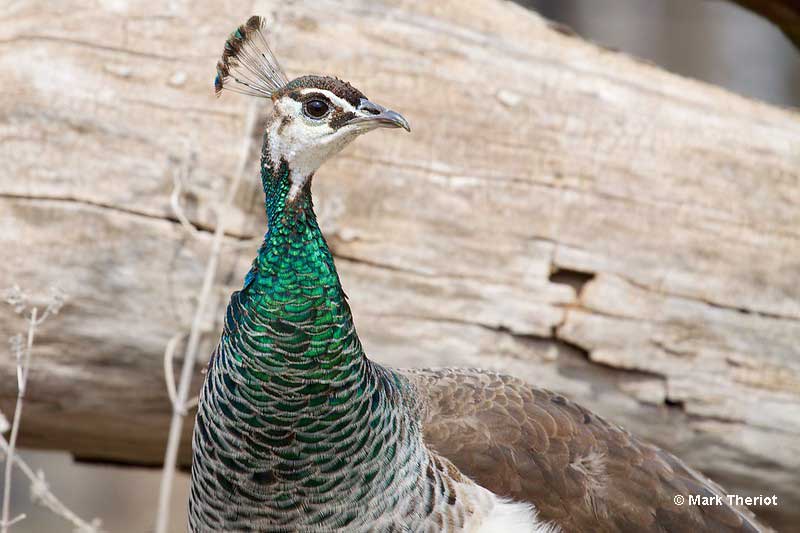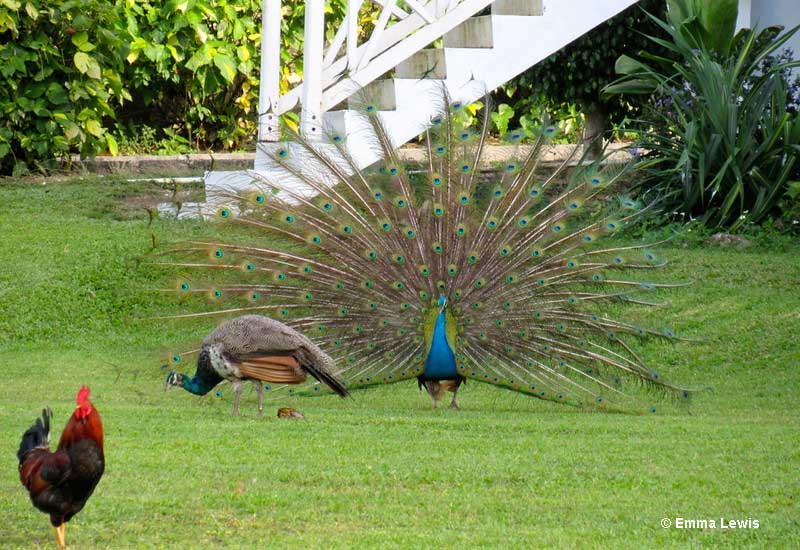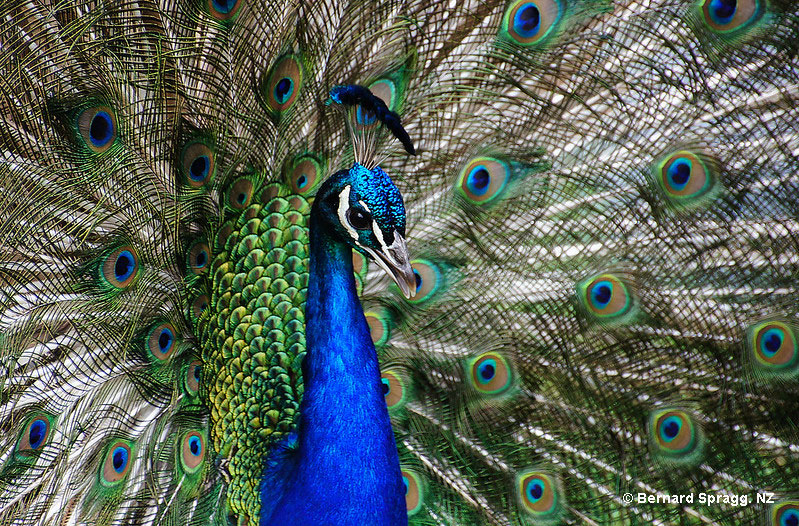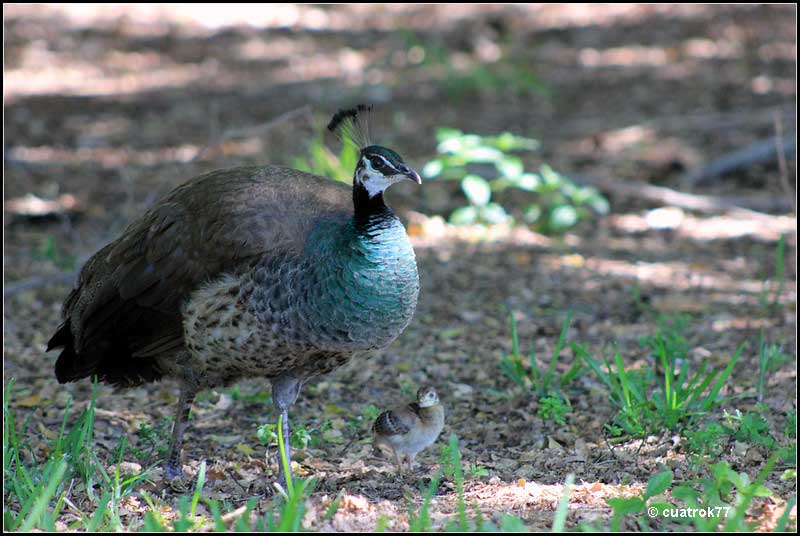
The female peacock is not as well known as their male counterparts. The peacock, or “Indian Peafowl”, is one of the more extravagant bird species.
Made famous by the male’s incredible deep blue plumage and long tail, just about everyone is familiar with the male peacock!
But what about the female peacock? Although she might not look at outrageous as her male counterpart, female peacocks are still beautiful, exotic birds in their own special way.
Known as a “peahen”, she has softer, brownish-gray plumage, and lacks the male’s long tail. However, she does all the work raising and defending her nestling “peachicks.” In doing so, the tough peahen ensures the continued survival of her species.
How else do male and female peacocks differ? See this article to learn more!
On this page
Female vs Male Peacock
Although male and female peacocks look similar enough to know that they belong to the same species, they have some major differences. In general, to separate male and female peacocks, all we have to do is look at their colors and the length of the tail.

Male peacocks can easily be identified by their beautiful vibrant plumage, but females have more laid-back plumage. © Emma Lewis
If the bird looks like the classic, well-known “peacock”, it is a male. In other words, male Indian Peafowls have a deep iridescent blue head, neck, and breast, and a dark green, scaled pattern on their belly.
They also have a fine, black-and-white pattern on their back, but, most of all, males have an incredibly long tail. It can be four and a half to five foot long, is iridescent green with golden highlights, and has bronze and blue “eyespots”.
Related: Can Peacocks Fly?
Female peacocks are a bit smaller than males and don’t have any dark blue or other flashy colors. Instead, they have a dull green and gray scaled pattern on their neck, and a white belly.
However, the tail is the biggest difference between male and female peacocks. Females have a much shorter, dull tail that doesn’t have any of the iridescence or eyespots shown by the male.
Scientific information
Some comparisons between male and female Peacocks.
| Male Peacock | Peahen | |
| Size | Noticeably larger with a body that is 39 – 49 inches long. Counting the tail, they can be six and a half feet long! They weigh around 8.8 to 13.2 pounds. | Smaller, around 37 inches long. They weigh 6.1 – 8.8 pounds. |
| Plumage | Males have beautiful blue and green plumage and a long, iridescent tail decorated with eyespots. | Female peacocks are much duller gray birds with a white belly, dull green on their neck, and a much shorter, grayish tail. |
| Behaviors | Male peacocks have an elaborate courtship display where they raise, spread, and shiver their huge tail. | On rare occasions, female peacocks raise and fan their tail when defending territory from other females and in defense of their young. |
| Sounds | The male bird often makes characteristic, loud wailing sounds, “kuWAAAH..kuWAAAH.. “kuWAAAH”. | When alarmed, the Peahen makes a clucking, “kuk kuk” calls. |
| Life Expectancy | Their average lifespan in the wild is 15 years but they can live to be 25 or more in captivity. | Female Indian Peafowls are believed to live a bit less than males, possibly to 12 years in captivity. |
Plumage
Both male and female peacocks have chestnut-colored flight feathers in their wings, a perky, plumed crest, and white on their face. However, beyond those similarities, they look pretty different.
Male peacocks are deep blue and dark green with an extra-long tail. Their exaggerated tail is iridescent bronze and golden green with blue and gold eyespots.
Related: What do peacock feathers symbolize?

Male peacock© Bernard Spragg. NZ
Females, on the other hand, are grayish birds with a white belly, white throat, and a much shorter, grayish tail. Their neck also has a scaled pattern with dark green highlights.
Both sexes also have a finely patterned, black and white back, but the female’s back is much duller.
Size
Male and female peacocks are big birds around the same size as a Wild Turkey but with longer necks and longer tails.
When comparing the sexes, the male peacock is larger, even without his huge tail. The body of the male peacock is around 39 to 49 inches long while the female peacock is 37 inches long. If we include his tail, the male can be more than six and a half feet long!
Males also weigh more and big individuals can be more than 13 pounds. The biggest females, on the other hand, can weigh 8.8 pounds, as much as the largest males.
Behavior
Male and female peacocks both spend much of their time picking small animals and grains from the ground and avoiding predators. However, other than that, their behaviors are fairly different.
The male peacock is much more vocal and often makes loud wailing calls. The female is usually quiet and only makes clucking calls when alarmed.
Males also have a well-known, elaborate courtship display. He raises and spreads his tail above and nearly in front of his body and then shivers the feathers.
When displaying directly to the female, he moves in close and leans towards her.
She also views his tail display from behind the tail as well as in front of it.
Related: What do peacocks symbolize?
Females can spread their tail but only do so to defend their territory or to possibly scare small predators away from their young. Females also take care of all of the nesting duties, including raising and protecting the nestlings.
How to tell a younger Peacock’s gender?

Female peacock with a baby peacock. © cuatrok77
After baby peacocks are hatch, male and female birds look the same. However, after a few months, males usually have darker chests and start to show signs of their long tail train. If they show any green or other iridescent colors in the tail, the bird is a male.
Juvenile males also have longer legs and are bigger than females, but these traits can be hard to judge.
Lifecycle
This species lays four to six eggs each year. In the wild, they begin nesting at the start of the wet season but can nest any time of year in captivity. The female incubates the eggs for 28 days and then helps protect her young for 9 months.
Although the young birds forage on their own, they follow the female around shortly after hatching. To help protect them, she leads her nestlings to dense cover and tree roosts for the night.
Young birds reach maturity after three years. In the wild, they usually live for 12 to 15 years but can live much longer in captivity.
Frequently Asked Questions
What is a female peacock called?
A female peacock is called a “peahen.”
What is special about female peacocks?
The female peacock is special because she doesn’t have the male’s bright colors or long tail but is still a fancy bird with a perky, fanned crest. She also takes care of the young Peacocks (Peachicks).
Can peacocks fly?
Yes, peacocks can fly but only for short distances. They usually fly up to a perch to escape predators.
Why are peacocks so colorful?
Peacocks are so colorful because they use their colors to attract and impress a mate.
Conclusions
Male and female peacocks have similar heads and look similar enough to know that they are the same species.
However, males are more colorful with blue and green plumage, and a long, fancy iridescent tail. Females are much duller, only rarely fan their tails, and do not give the loud wailing calls that the males make. They also do all the work to raise their young.

